Multi-Scale Decomposition and Hybrid Deep Learning CEEMDAN-VMD-CNN-BiLSTM Approach for Wind Power Forecasting
Abstract
1. Introduction
2. Theoretical Basis
2.1. CEEMDAN
- Adding white noise:
- First-order intrinsic mode component C1(k):
- IMF of the first iteration:
- Residual r1(t):
- Iterative decomposition: The above steps are repeated to successively extract C2(t), C3(t), …, until the residual rm(t) becomes a monotonic signal. Finally, the original signal y(t) is decomposed into m IMF components and one residual:
2.2. Sample Entropy Calculation
- Embed the time-series x into an m-dimensional space to construct embedding vectors:
- For each embedding vector Xim, calculate the Euclidean distance dij to all other embedding vectors Xim.
- Set the similarity tolerance r, typically r = 0.2std(x).
- For each Xim, calculate the proportion of embedding vectors Cim(r) that satisfy dij ≤ r.
- The sample entropy is defined as follows:
2.3. K-Means Clustering
- Randomly select k samples as the initial cluster centers C1, C2, …, Ck.
- Assign each sample xi to the nearest cluster center:
- Recalculate the center of each cluster:
- Repeat the sample assignment and cluster center update steps until the cluster centers no longer change, or the maximum number of iterations is reached.
2.4. Variational Mode Decomposition
2.5. CNN
2.6. BILSTM
3. Construction of CEEMDAN-VMD-CNN-BILSTM Model
3.1. Model Framework Design
3.1.1. Signal Decomposition of CEEMDAN
3.1.2. CNN Spatiotemporal Feature Extraction
3.1.3. BiLSTM Sequence Modeling
3.1.4. Forecasting Output
3.2. Data Processing and Preparation
3.3. Model Parameter Setting and Optimization
3.3.1. CEEMDAN Parameter Selection
3.3.2. VMD Parameter Selection
3.3.3. CNN Parameter Selection
3.3.4. BILSTM Parameter Selection
4. Experimental Results and Analysis
4.1. Model Performance Evaluation Metrics
4.2. Signal Decomposition
4.2.1. Data Source
4.2.2. CEEMDAN Decomposition
4.2.3. Sample Entropy Calculation and K-Means Clustering
4.2.4. VMD Secondary Decomposition
4.2.5. Spectral Analysis
- IMF1: The dominant frequency range is approximately 0.05 Hz, corresponding to short-term rapid fluctuations, which reflects the gust characteristics in wind power generation.
- IMF2: The dominant frequency range is around 0.03 Hz, indicating relatively fast variations, likely associated with short-term wind speed fluctuations.
- IMF3: The dominant frequency is roughly 0.02 Hz, representing medium-term fluctuation features and reflecting slight changes in the operational status of equipment in wind power systems.
- IMF4: The dominant frequency is about 0.01 Hz, embodying low-frequency trends, potentially linked to periodic equipment maintenance or environmental factors in wind power generation.
- IMF5: The dominant frequency is approximately 0.005 Hz, corresponding to long-term trend changes, such as daily temperature differences or seasonal variations in wind power generation.
4.3. Comparison of Forecast Results
4.3.1. Quantitative Result Analysis
- MSE (67.145) and RMSE (8.192) indicate a 28.1% and 34.6% reduction compared to the next-best VMD-CNN-LSTM model, indicating minimal deviation between predicted and true values.
- MAE (6.020) is 64.1% lower than CEEMDAN-LSTM, reflecting precise capture of extreme values.
- R2 (0.9840) is nearly 1, indicating that the model explains 98.4% of wind power fluctuations, with generalization ability significantly superior to traditional statistical models (e.g., ARIMA’s R2 = 0.8936).
4.3.2. Qualitative Result Analysis
- Training Set Fitting Ability (Figure 10): The prediction curve of CEEMDAN-VMD-CNN-BiLSTM nearly overlaps with the true value curve, maintaining high fitting accuracy even during wind speed mutation periods (e.g., samples 1100–1200).
- Test Set Generalization Ability (Figure 11): The model accurately captures unseen short-term fluctuations (e.g., peaks in samples 500–600) and long-term trends (e.g., downward trends in samples 700–900), while LSTM and ARIMA show significant lag or trend deviation.
- Error Distribution (Figure 12): Figure 12 presents the distribution of prediction errors of the model. It can be seen that the difference between the predicted values and the actual values mostly concentrates within the range of ±10 MW, indicating that the deviation between the model’s prediction results and the true values is small.
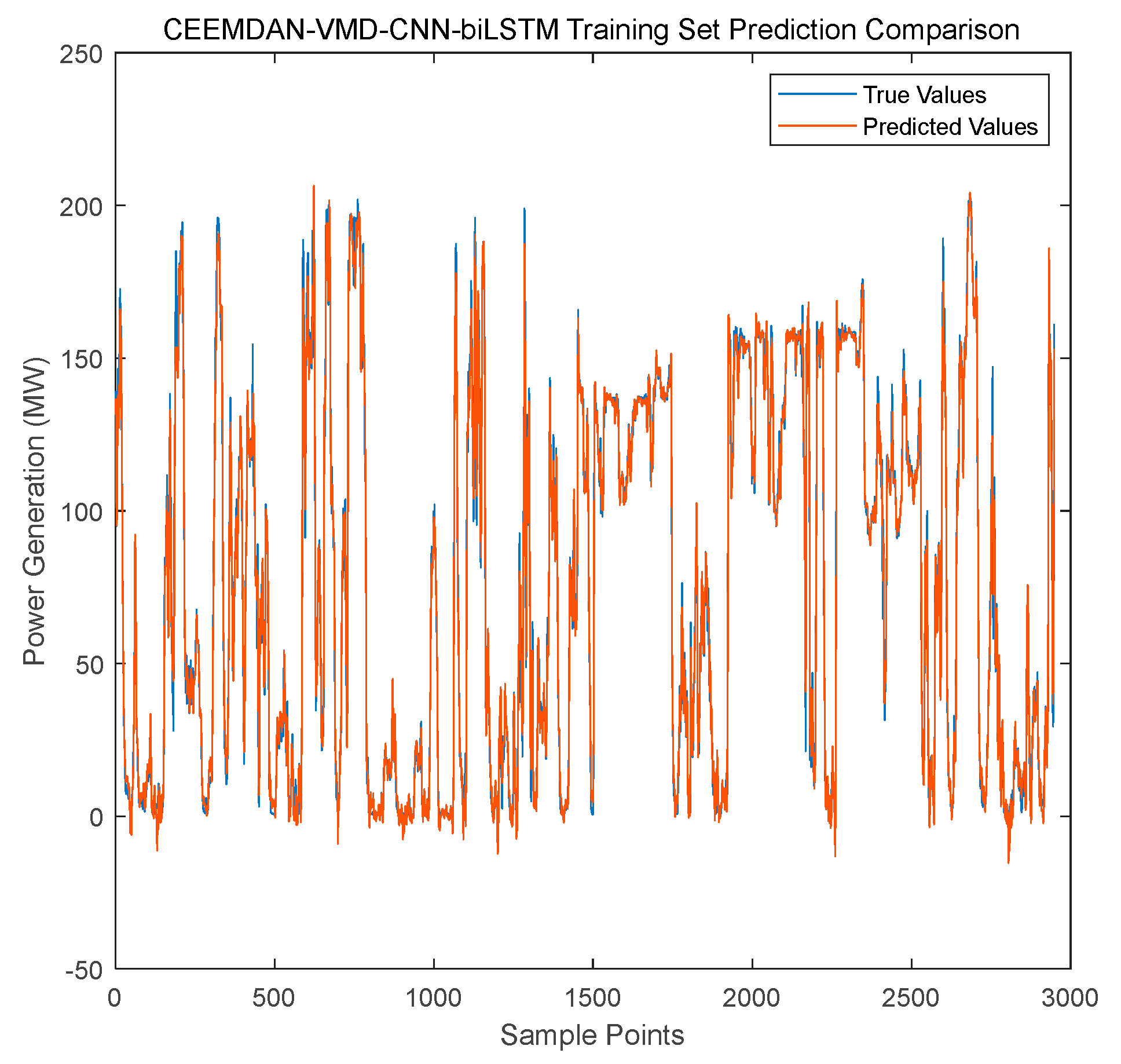

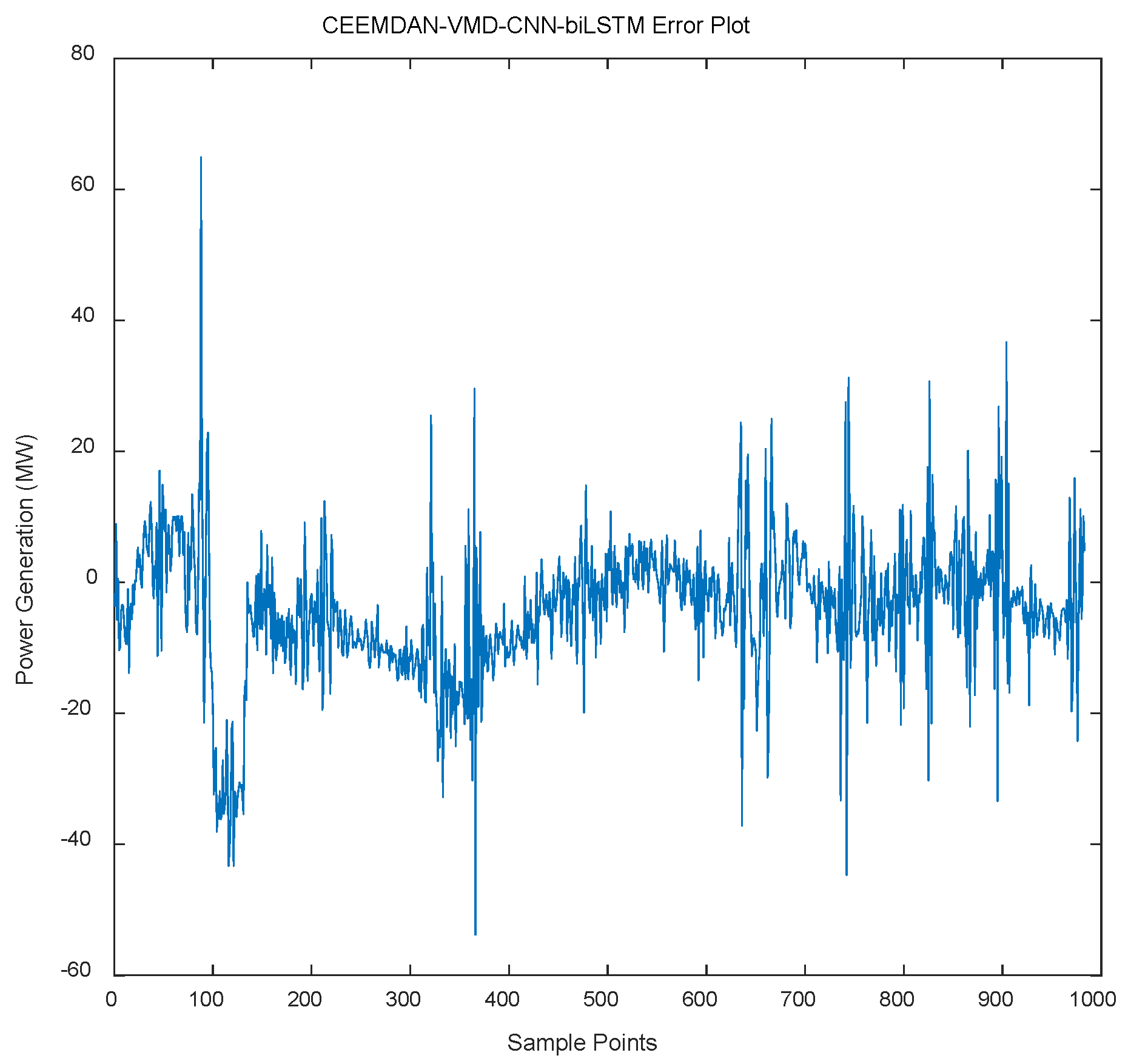
5. Discussion
6. Conclusions
6.1. Main Conclusions
- Effectiveness of Multi-Scale Decomposition: Through the cascaded decomposition of CEEMDAN and VMD, the original signal is deconstructed into 12 intrinsic mode functions (IMFs) and 4 sub-modes, successfully separating multi-scale components such as high-frequency gust fluctuations, medium-frequency equipment vibrations, and low-frequency diurnal trends.
- Superiority of the Hybrid Model: The synergistic effect of CNN and BiLSTM enables efficient capture of spatiotemporal features—CNN extracts local correlation patterns of wind speed–wind direction combinations through 3×3 convolutional kernels, while BiLSTM captures bidirectional temporal dependencies through 128-dimensional hidden layer nodes. As a result, the model achieves an R2 of 0.9840 and an MAE of only 6.020 on the test set, reducing errors by over 80% compared to the traditional ARIMA model.
- Reliability of Experimental Validation: Compared with comparative models such as ARIMA, LSTM, and CEEMDAN-LSTM, this model significantly leads in key metrics such as MSE (67.145) and RMSE (8.192).
6.2. Future Outlook
- Lightweight Algorithm Design: Develop a fast ensemble strategy for CEEMDAN to reduce the number of ensemble averages from 500 to less than 200 while introducing a mechanism to dynamically adjust the VMD penalty factor α to balance decomposition accuracy (error ≤ 3%) and computational efficiency.
- Application of Federated Learning: Aggregate data from multiple wind farms based on a federated learning architecture to expand the diversity of training samples while protecting data privacy (planning to include data from over 50 wind farms), further improving the model’s generalization ability to complex working conditions and providing a more efficient solution for dynamic stability management of smart grids.
- Application Scenario Constraints: The model is primarily designed for short-term forecasting of single wind farms. When applied to joint forecasting across regional multi-wind farms, it is necessary to consider spatial correlation modeling and data privacy protection.
Author Contributions
Funding
Data Availability Statement
Conflicts of Interest
References
- Zhou, S.; Chen, Z.; Lu, Z.; Huang, Y.; Ma, S.; Zhao, Q. Technical characteristics of China’s new generation power system in energy transition. Proc. CSEE 2018, 38, 1893–1904. [Google Scholar]
- Zhu, J.; Dong, H.; Li, S.; Chen, Z.; Luo, T. Review of data-driven load forecasting for integrated energy system. Proc. CSEE 2021, 41, 7905–7923. [Google Scholar]
- Yang, M.; Wang, D.; Wang, X.; Fan, F.; Gao, B. Ultra-short-term wind power prediction model based on hybrid data-physics-driven approach. High Volt. Eng. 2024, 50, 5132–5141. [Google Scholar]
- Zou, Y. Survey of wind power output forecasting technology. IEEE Trans. Sustain. Energy 2021, 13, 890–901. [Google Scholar] [CrossRef]
- Li, J.; Hu, X.; Qin, J.; Zhang, C. Ultra-short-term wind power prediction based on multi-head attention mechanism and convolutional model. Power Syst. Prot. Control 2023, 51, 56–62. [Google Scholar]
- Wang, D.; Lu, Z.; Jia, Q. Medium-long-term wind power prediction based on multi-model optimized combination. Renew. Energy 2018, 36, 678–685. [Google Scholar]
- Mei, R.; Lyu, Z.; Gu, W.; Yang, H.Y.; Xiao, P. Short-term wind power prediction based on principal component analysis and spectral clustering. Autom. Electr. Power Syst. 2022, 46, 98–105. [Google Scholar]
- Chen, H.; Li, H.; Kan, T.; Zhao, C.; Gao, Z. Ultra-short-term wind power prediction considering temporal characteristics using deep wavelet-temporal convolutional network. Power Syst. Technol. 2023, 47, 1653–1665. [Google Scholar]
- Shen, X.; Zhou, C.; Fu, X. Wind speed prediction of wind turbine based on the internet of machines and spatial correlation weight. Trans. China Electrotech. Soc. 2021, 36, 1782–1790,1817. [Google Scholar]
- Liu, S.; Zhu, Y.; Zhang, K.; Gao, J.C. Short-term wind power prediction based on error-corrected ARMA-GARCH model. Acta Energiae Solaris Sin. 2020, 41, 268–275. [Google Scholar]
- Huang, R.; Yu, Z.; Deng, Y.; Zeng, X.L. Short-term wind speed prediction based on SVM under different feature vectors. Acta Energiae Solaris Sin. 2014, 35, 866–871. [Google Scholar]
- Wang, W.; Liu, H.; Chen, Y.; Zheng, N.; Li, Z.; Ji, X.; Yu, G.; Kang, J. Wind power prediction based on LSTM recurrent neural network. Renew. Energy 2020, 38, 1187–1191. [Google Scholar]
- Liang, C.; Liu, Y.; Zhou, J.; Yan, J.; Lu, Z. Multi-point wind speed prediction method within wind farm based on convolutional recurrent neural network. Power Syst. Technol. 2021, 45, 534–542. [Google Scholar]
- Wang, D.; Fu, X.; Du, S. Ultra-short-term wind power prediction based on adaptive VMD-LSTM. J. Nanjing Univ. Inf. Sci. Technol. 2025, 17, 74–87. [Google Scholar]
- Liao, X.; Chen, C.; Wu, J. Spatiotemporal combined prediction model for wind farms based on CNN-LSTM and deep learning. Inf. Control 2022, 51, 498–512. [Google Scholar] [CrossRef]
- Li, L.; Gao, G.; Wu, W.; Wei, Y.; Lu, S.; Liang, J. Short-term day-ahead wind power prediction method considering feature reorganization and improved Transformer. Power Syst. Technol. 2024, 48, 1466–1480. [Google Scholar]
- Liao, X.; Wu, J.; Chen, C. Short-term wind power prediction model combining attention mechanism and LSTM. Comput. Eng. 2022, 48, 286–297, 304. [Google Scholar]
- Wang, S.; Liu, H.; Yu, G. Short-term wind power combination forecasting method based on wind speed correction of numerical weather prediction. Front. Energy Res. 2024, 12, 1391692. [Google Scholar] [CrossRef]
- Flandrin, P.; Torres, E.; Colominas, M.A. Complete ensemble empirical model decomposition with adaptive noise. In Proceedings of the 2011 IEEE International Conference on Acoustics, Speech and Signal Processing, Prague, Czech Republic, 22–27 May 2011; IEEE: Piscataway, NJ, USA, 2011; pp. 4144–4147. [Google Scholar]
- Liu, Y.; Chen, X. Short-term wind speed and power forecasting using empirical mode decomposition and least squares support vector machine. Renew. Energy 2012, 50, 1–7. [Google Scholar]
- Li, Y.; Li, J.; Wang, Y. Fault diagnosis of rolling bearings using sample entropy and convolutional neural networks. Mech. Syst. Signal Process. 2020, 135, 106418. [Google Scholar]
- Richman, J.S.; Moorman, J.R. Physiological time-series analysis using approximate entropy and sample entropy. Am. J. Physiol.-Heart Circ. Physiol. 2000, 278, H2039–H2049. [Google Scholar] [CrossRef] [PubMed]
- Jain, A.K.; Murty, M.N.; Flynn, P.J. Data Clustering: A Review. ACM Comput. Surv. 1993, 31, 264–323. [Google Scholar] [CrossRef]
- Alkesaiberi, A.; Harrou, F.; Sun, Y. Efficient wind power prediction using machine learning methods: A comparative study. Energies 2021, 15, 2327. [Google Scholar] [CrossRef]
- Xu, X.; Pan, T.; Wu, D. Wind speed noise reduction in wind farm based on variational mode decomposition. Energy 2018, 179, 263–274. [Google Scholar]
- Li, X.; Li, K.; Shen, S.; Tian, Y. Exploring time series models for wind speed forecasting: A comparative analysis. Energies 2023, 16, 7785. [Google Scholar] [CrossRef]
- Zhu, A.; Li, X.; Mo, Z.; Wu, R. Wind power prediction based on a convolutional neural network. J. Renew. Energy 2016, 108, 482–490. [Google Scholar]
- Hameed, Z.; Garcia-Zapirain, B. Sentiment classification using a single-layered BiLSTM model. IEEE Access 2020, 8, 73992–74001. [Google Scholar] [CrossRef]
- Michael, N.E.; Bansal, R.C.; Ismail, A.A.A.; Elnady, A.; Hasan, S. A cohesive structure of bidirectional long-short-term memory (BiLSTM)-GRU for predicting hourly solar radiation. Renew. Energy 2024, 222, 119943. [Google Scholar] [CrossRef]
- Amezquita-Sanchez, J.P. Short-term wind power prediction based on anomalous data cleaning and optimized LSTM network. J. Renew. Energy 2023, 210, 45–53. [Google Scholar]
- Prasad, M.; Srikanth, T. Clustering Accuracy Improvement Using Modified Min-Max Normalization Technique. arXiv 2024, arXiv:2411.07000. [Google Scholar]
- Bai, W.; Chang, Y. Denoising of blasting vibration signals based on CEEMDAN-ICA algorithm. Sci. Rep. 2023, 13, 20928. [Google Scholar]
- Dragomiretskiy, K.; Zosso, D. Variational mode decomposition. IEEE Trans. Signal Process. 2013, 62, 531–537. [Google Scholar] [CrossRef]
- Zhou, Z.; Chen, W.; Yang, C. Adaptive range selection for parameter optimization of VMD algorithm in rolling bearing fault diagnosis under strong background noise. J. Eng. Appl. Sci. (RESE) 2023, 12, 45–56. [Google Scholar]
- Dong, M.; Han, J. HAR-Net: Fusing Deep Representation and Hand-crafted Features for Human Activity Recognition. arXiv 2018, arXiv:1810.11526. [Google Scholar]
- Huang, Z.; Gu, C.; Peng, J.; Wu, Y. A Statistical Prediction Model for Sluice Seepage Based on MHHO-BiLSTM. Water 2024, 16, 191. [Google Scholar] [CrossRef]
- Chicco, D.; Warrens, M.; Jurman, G. The coefficient of determination R-squared is more informative than SMAPE, MAE, MAPE, MSE and RMSE in regression analysis evaluation. PeerJ Comput. Sci. 2021, 7, e623. [Google Scholar] [CrossRef]

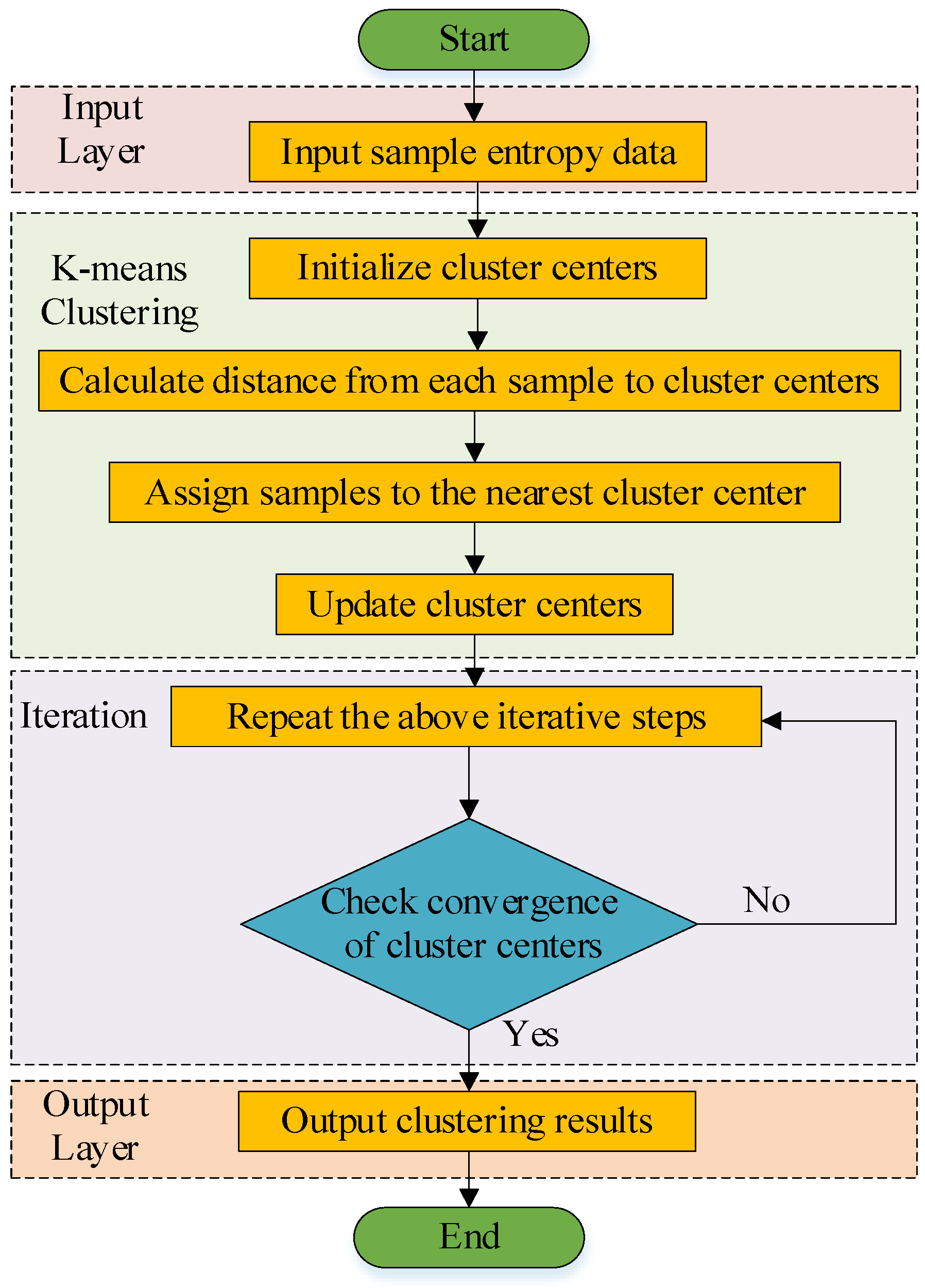
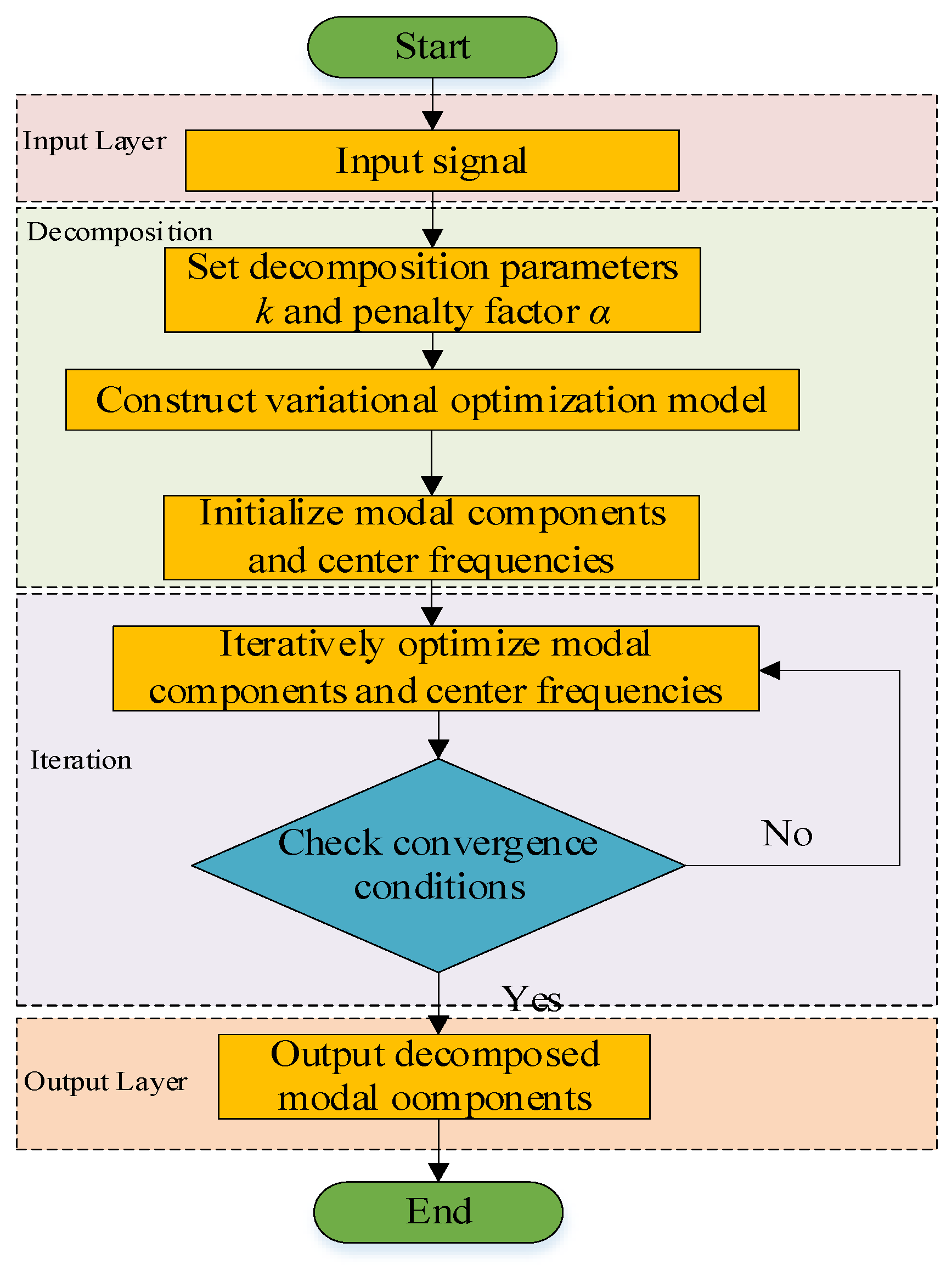

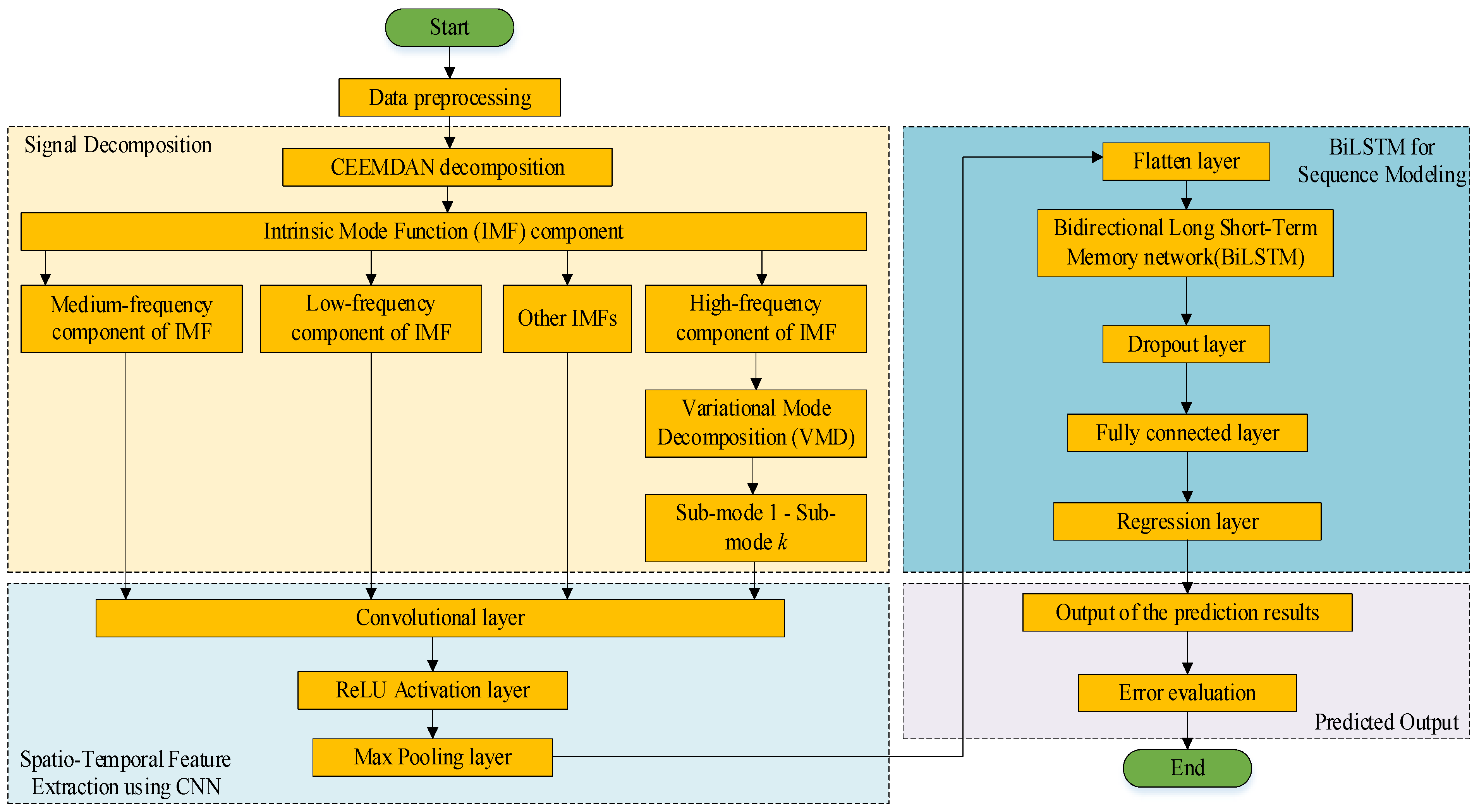

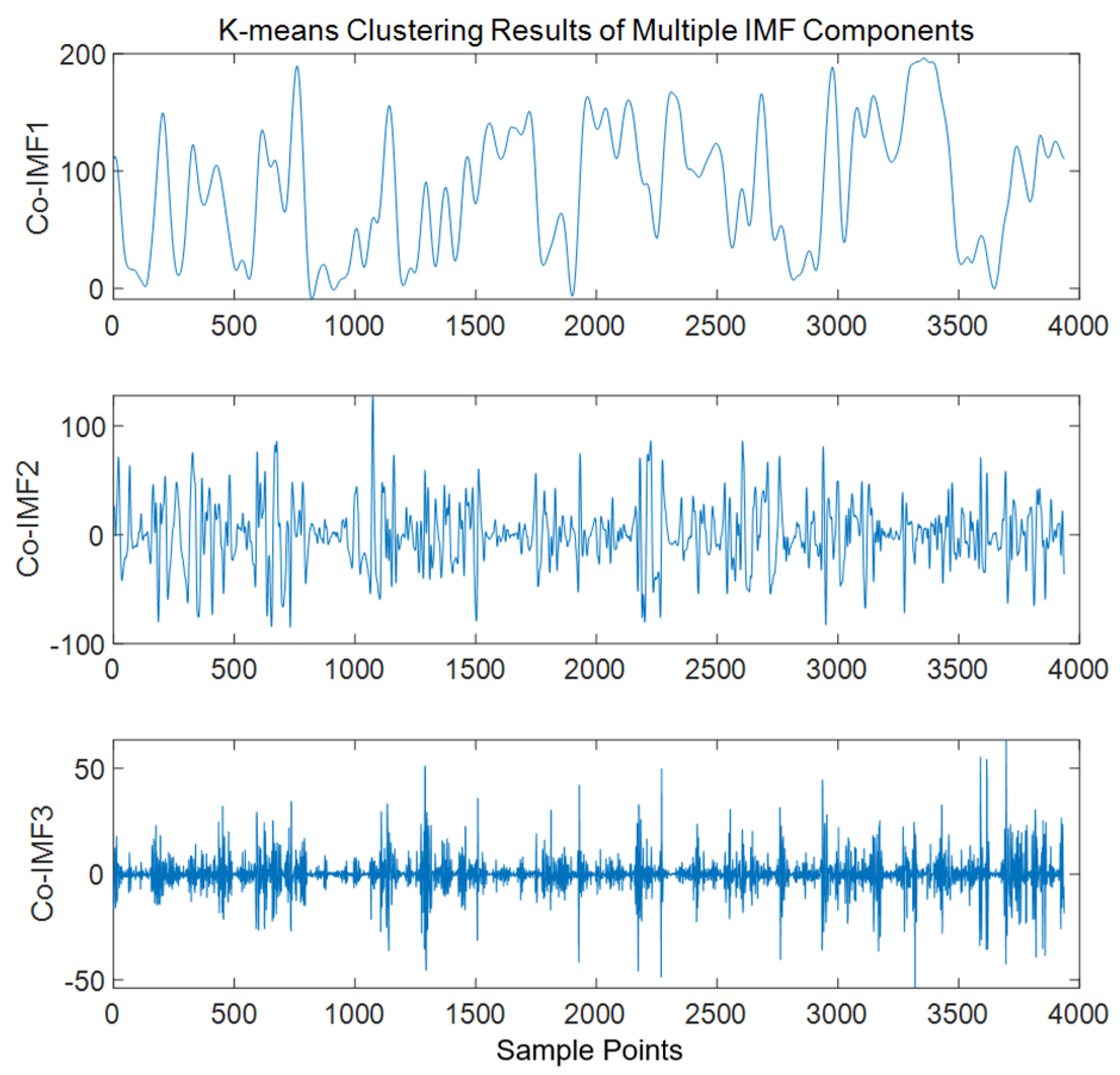

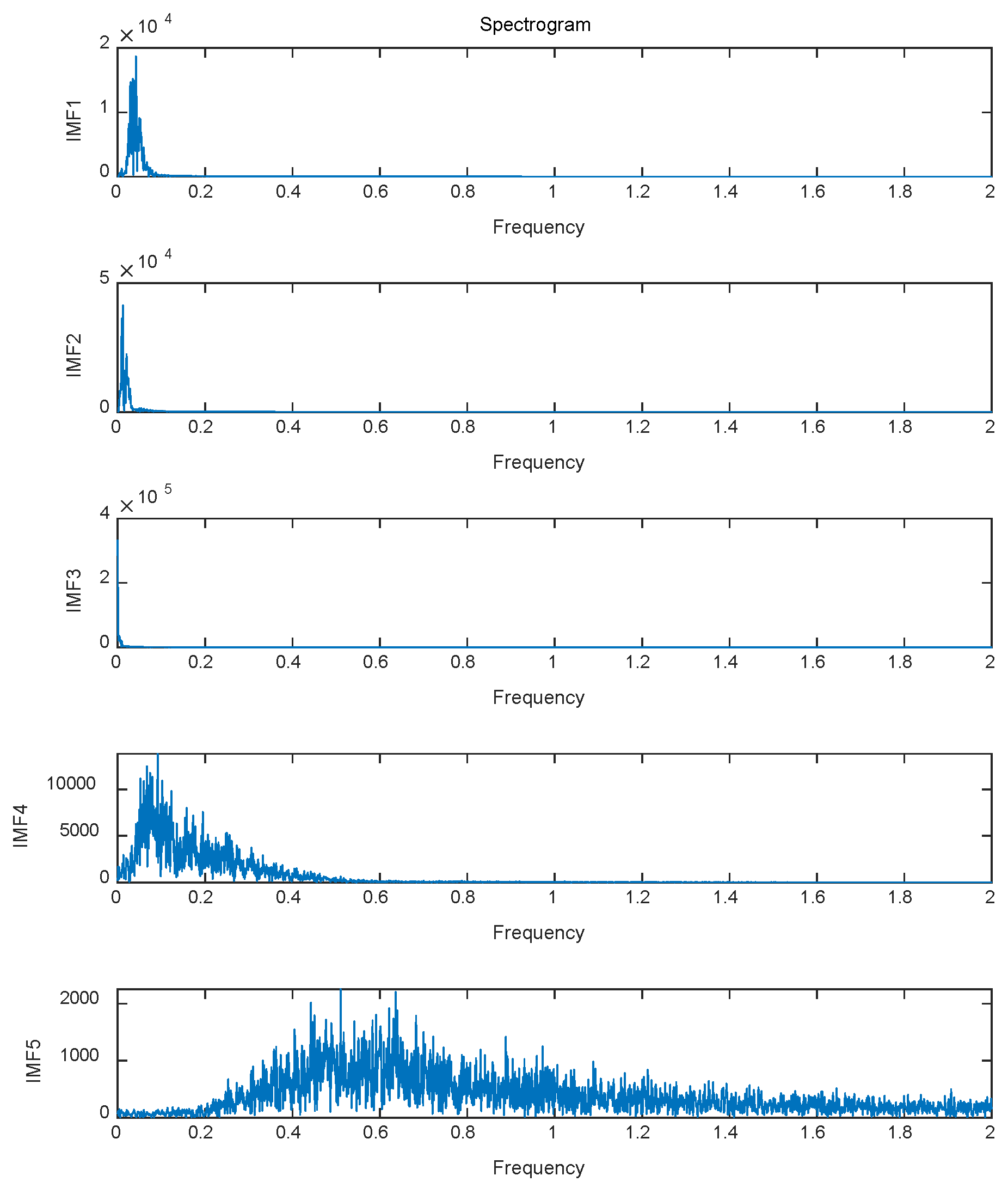
| Abbreviation | Full Term |
|---|---|
| ARIMA | Autoregressive integrated moving average model |
| BiLSTM | Bidirectional long short-term memory |
| CEEMDAN | Complete ensemble empirical mode decomposition with adaptive noise |
| CNN | Convolutional neural network |
| FFT | Fast Fourier transform |
| IMF | Intrinsic mode function |
| LSTM | Long short-term memory |
| MAE | Mean absolute error |
| MAPE | Mean absolute percentage error |
| MSE | Mean squared error |
| SSA | Sparrow optimization algorithm |
| SVM | Support vector machine |
| ReLU | Rectified linear unit |
| RMSE | Root mean squared error |
| VMD | Variational mode decomposition |
| Models | Evaluation Indicator | |||
| MSE | RMSE | MAE | R2 | |
| ARIMA | 305.915 | 36.849 | 31.140 | 0.8936 |
| LSTM | 260.913 | 28.075 | 25.648 | 0.9125 |
| CEEMDAN-LSTM | 140.078 | 20.226 | 16.75 | 0.9578 |
| VMD-CNN-LSTM | 93.436 | 12.526 | 8.373 | 0.9575 |
| CEEMDAN-VMD-CNN-BiLSTM | 67.145 | 8.192 | 6.020 | 0.9840 |
Disclaimer/Publisher’s Note: The statements, opinions and data contained in all publications are solely those of the individual author(s) and contributor(s) and not of MDPI and/or the editor(s). MDPI and/or the editor(s) disclaim responsibility for any injury to people or property resulting from any ideas, methods, instructions or products referred to in the content. |
© 2025 by the authors. Licensee MDPI, Basel, Switzerland. This article is an open access article distributed under the terms and conditions of the Creative Commons Attribution (CC BY) license (https://creativecommons.org/licenses/by/4.0/).
Share and Cite
Ning, Z.; Chen, G.; Wang, J.; Hu, W. Multi-Scale Decomposition and Hybrid Deep Learning CEEMDAN-VMD-CNN-BiLSTM Approach for Wind Power Forecasting. Processes 2025, 13, 2046. https://doi.org/10.3390/pr13072046
Ning Z, Chen G, Wang J, Hu W. Multi-Scale Decomposition and Hybrid Deep Learning CEEMDAN-VMD-CNN-BiLSTM Approach for Wind Power Forecasting. Processes. 2025; 13(7):2046. https://doi.org/10.3390/pr13072046
Chicago/Turabian StyleNing, Zhanhu, Guoping Chen, Jiwu Wang, and Wei Hu. 2025. "Multi-Scale Decomposition and Hybrid Deep Learning CEEMDAN-VMD-CNN-BiLSTM Approach for Wind Power Forecasting" Processes 13, no. 7: 2046. https://doi.org/10.3390/pr13072046
APA StyleNing, Z., Chen, G., Wang, J., & Hu, W. (2025). Multi-Scale Decomposition and Hybrid Deep Learning CEEMDAN-VMD-CNN-BiLSTM Approach for Wind Power Forecasting. Processes, 13(7), 2046. https://doi.org/10.3390/pr13072046






